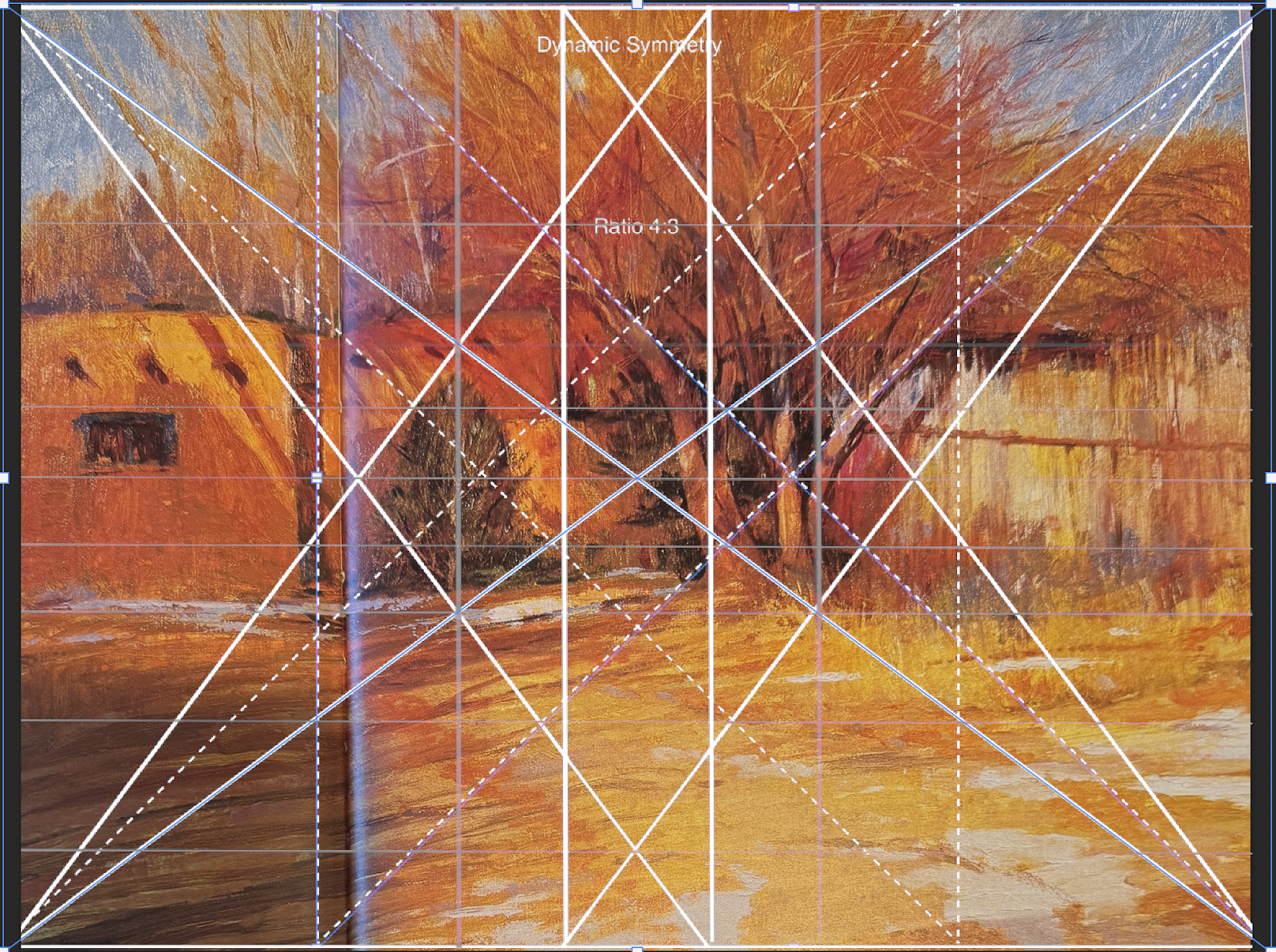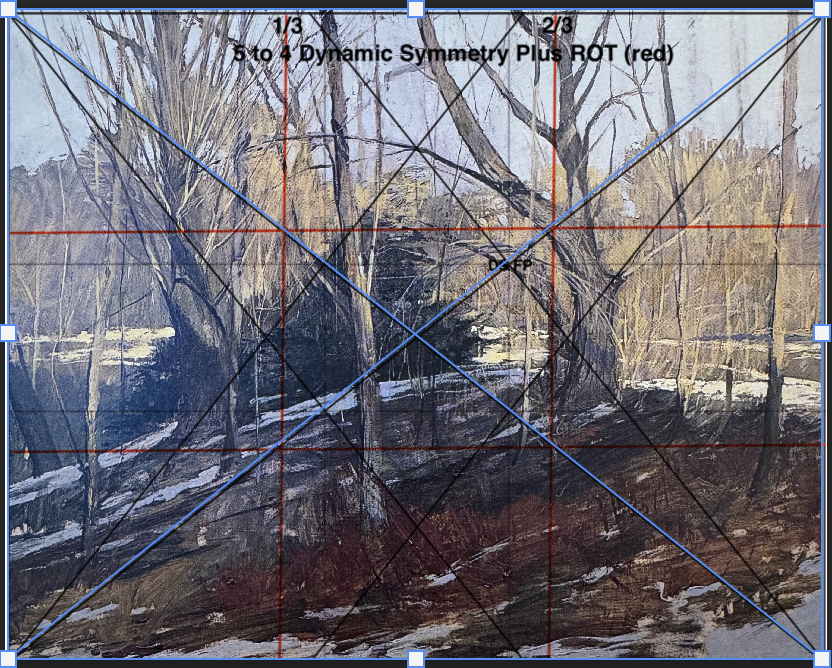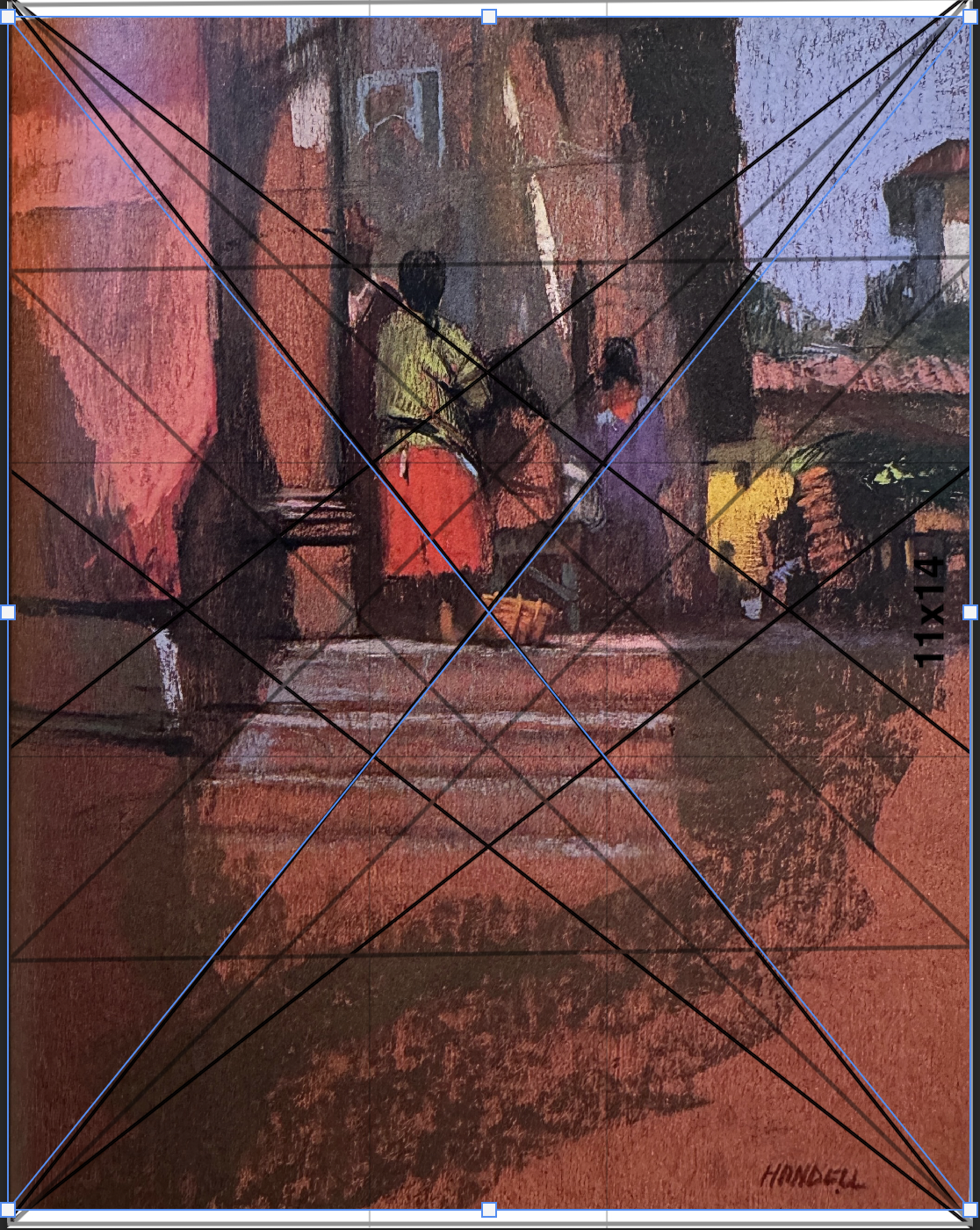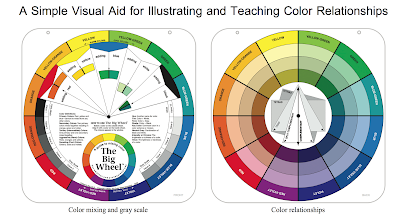Albert Handell Intuitive Composition Part II
Albert Handell Intuitive Composition Part II
Armatures applied to additional paintings chosen from the 1988 Albert Handell book, Intuitive Composition.
I am very excited to share with you some information I have gathered from Albert’s book, Intuitive Composition. As I continue to re-read the book, I see references to composition principles, many which seem to be based on Mathematics or Geometry sometimes found in Dynamic Symmetry (at least from my point of view).
I have selected paintings from the second part of his book that have descriptions that emphasize compositional elements that are worth analyzing from the point of view of Dynamic Symmetry. The comments reveal to me a deep interest in many of the aspects of Dynamic Symmetry. I have quoted some of the descriptions and applied armatures to the paintings for further analysis. There is much more in this book and I highly recommend it.
The assumption of Intuitive Composition, is that Handell uses intuition to design his paintings and as mentioned before, the Dynamic Symmetry of Jay Hambidge, though valuable is impractical. It seems to me that Albert pays very close attention to many elements of composition and spends time thinking about these continually while he paints. This is evident in the comments and descriptions included here.
How do these composition principles fit with his intuitive decisions? Does his intuition align with the elements of Dynamic Symmetry? Study each armature to help answer this question and others.
-
Do you see the main areas of interest or the focal point lining up with the armature in the photos?
-
Are there elements of interest on lines leading to the main areas of interest?
-
Does the horizon land on an armature horizonal, explicitly or implicitly?
-
Do the main shapes of the painting fall within the geometrical figures implied in the
armatures?
-
Do shapes repeat themselves perhaps in smaller versions – but with the same
proportions?
Previous paintings were selected primarily to illustrate rock and water paintings. In this document, paintings were chosen to illustrate composition principles, without regard to the subject matter, especially if they imply principles seen within Dynamic Symmetry or other Armatures of the Rectangle: additional sections of Intuitive Composition: Opposed and Unopposed Angles, Symmetry and Asymmetry, Tension, Proportional Relationships, Linear and Aerial Perspective, Center of Interest in Composition, Placement, Simplifying Shapes and Unifying Compositions, Backgrounds in Compositions, Division of the Picture Plane, Using Repetition.
Opposed and Unopposed Angles
“There are different types of angles. In geometry, there are right angles, obtuse angles, acute angles. In designing paintings, there are opposed and unopposed angles.
“There is an unopposed type of angle in which the lines of the angle are like a railroad track in perspective. They simply meet at a point and the eye is like a train riding the lines of that track...
“Opposed angles and combinations of opposed angles basically keep each other in check. There is generally more weight and more tension than speed to them. The opposed angles are worked in to the design a bit like a tightly knit chess game, where things are balanced against one another.
“Earlier we observed the effects of horizontal vertical and diagonal movements separately, as they create balance and thrusts within the compositional framework. Here we are looking more closely at how opposed angles, by themselves or in combination, can balance movements, be dynamic and at times have an off-balancing effect...
Tension
Albert Handell, THE CATSKILL STREAM, 20x24 5 to 6 Expanded Dynamic Symmetry
“Compositional tension is a spatial sensation of “static” activity that creates a dynamically alive
painting..”
“With regard to shapes, all shapes are in some way variations on circles, squares or triangles”
“The subjective us of directional lines can also create a sense of compositional tension... In a
sense, tension can be defined as the attraction, repulsion and interaction of the diverse
compositional elements.”
In this painting, “The eye is allowed to wander throughout the composition. This movement keeps the eye in the painting”.
Proportional Relationships
Albert Handell, PECOS WILDERNESS, 20x24, 5 to 6 Expanded Dynamic Symmetry Armature
“ ..done correctly, good proportions and proportional relationships will give your compositions a strong sense of reality.”
“.. I go for the feeling of rocks, water and trees – an essence of nature – and work to balance the proportional relationships to express ths reality”.
Lines and Subjective Lines
Albert Handell, THE COYOTE FENCE, 20x26, 3 to 4 Expanded Dynamic Symmetry Armature
“In a composition, lines move dynamically through space. All lines point in some way, setting up
directions. Strong linear designs, straight or vigorously curving lines, or forms delineated by
sharp edges, all ted to create definite directions.
“Subjective lines are felt or implied directions to be visually completed by the observer.”
“Together, all these lines guide the eye in and out of the composition, leading it to the center of
interest, which is the tree and the areas of adobe and fencing adjacent to it.”
The First Impression
Albert Handell, TAOS WINTER, 12x16, 3 to 4 Basic Dynamic Symmetry Armature plus Rule of Thirds Armature (red)
“With a fresh eye, I harmoniously interweave the subject matter and the elements of the
composition. Although both intuition and intellectual decisions are involved, as much as possible
I allow intuition to lead. I do not intellectually conceive geometric shapes and then work out of
them...
As I analyze what made up my first impression, I try to abstract it into primarily large
shapes...... As the structure becomes clearer, the composition grows and develops, and that first
impression starts taking shape on the canvas. I go from there, never losing sight of the impact of
the first impression.”
Center of Interest:
“A powerful composition is achieved when the center of interest is reinforced by the design.
Artistic License:
Albert Handell, FEBRUARY WOODSTOCK, 24x30, 4 to 5 Basic Dynamic Symmetry Armature plus Rule of Thirds Armature (red).
“Using artistic license, I decided to focus in on the foreground. I raised the placement and line of the foreground hill a bit higher than it actually was.
“.. I kept the background simplified. That’s all that was needed to suggest the background.”
“Once you realize where the center of interest is within the carrying power of the painting, then you can consider using artistic license to selectively work with other elements.”
Placement
Albert Handell, MARKET STEPS, PATZCUARO, 16x11, EXPANDED Dynamic Symmetry Armature
“The placement of the center of interest affects the entire painting, and its compositional placement should always be determined in relation to the whole surface shape.
“Essentially, however, no matter what placement is chosen, a basic harmony and balance to the composition is being sought, and all subordinate areas of the composition must be harmoniously related.”
“In this painting, the eye level is a low eye level, somewhere well below the top step. The upper half of the composition is compact, dramatic and detailed...It is the tight placement of things above that line and the comparative emptiness below it that makes this composition unique and exciting. “
Simplifying Shapes and Unifying Compositions
Albert Handell, LAST LIGHT, SANTA FE, 11x16. 2 to 3 Expanded Dynamic Symmetry Armature
“.. simplifying, changing and modifying shapes is important to creating a strong unified composition.”
“.. the use of two-dimensional shapes helps the realistic painter achieve that sense of three dimensions.”
“ .. the massing of the different areas of the painting is perhaps the most important element involved in simplifying shapes and unifying compositions.”
“The subject... is a complicated arrangement of forms and shapes. The composition is divided practically in half.”
Backgrounds in Compositions
Albert Handell, TAOS COTTONWOOD, 18x20. Harmonic Armature
A harmonic armature was chosen since the 9 to 10 proportion is unusual, almost a square, and the Dynamic Symmetry Armature was not immediately available. But it’s of interest to use this armature to analyze the painting.
“Compositionally, the main focus is in keeping the background pattems well massed so that they do not jump out and come forward, disrupting the harmony and integration of the foreground-background relationships. Always keep the main focus where you intended – on the center of interest.”
Division of the Picture Plane
Albert Handell, SUNDAY’S SNOW, 30x36. 5 to 6 EXPANDED Dynamic Symmetry Armature
“Nearly all objects are understood through surface divisions made of lines or edges”
“Variety is achieved through horizontal, vertical or diagonal divisions and movements, etc. The central design elements .. may be placed in the center of the picture plane or to one side. Horizontals may be repeated by other horizontals or may be contrasted with verticals or diagonals that cut across whole or parts of areas.”
“No matter what the basic composition is it is essential to remember the shapes and movements of the subject relate to one another and to the picture plane, creating the divisions of the picture plane. These divisions are subtleties of the composition and intrinsic to the painting’s carrying power.”
Using Repetition
Albert Handell, THE WALL, 16x22 3 to 4 EXPANDED Dynamic Symmetry Armature
“Using repetition as a tool in a composition allows good opportunities to observe variety yet helps keep a harmony..”
“There is an echoing of one shape or detail by another...”
“Although the eye travels throughout this composition, ... when it views the painting the attention is unconsciously held by the subtle repetition in the trees.”
















